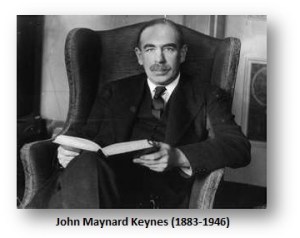June 9, 2024 | Why is Keynesian Economics Collapsing?

John Maynard Keynes in his 1936 book, ‘The General Theory of Employment, Interest and Money,” argued aggregate demand was too volatile to be stable and would lead to inflation or recessions. His theory honed in on spending as a means of price control. Low aggregate demand, Keynes argues, would lead to high unemployment and stagflation. Government could intervene through fiscal policies to increase aggregate demand, as an example, increased government spending could tame inflation. Interest rates, according to Keynes, could also be modified to encourage spending and stimulate demand. So why are these theories failing miserably today?
To begin, the United States had a balanced budget when Keynes presented his theory. The government is now the biggest borrower, acting in its own self interest under Adam Smith’s theory of the invisible hand that Keynes spent his career attempting to deny. According to Keynes, “there is no self-correcting mechanism in a free market economy that automatically restores full employment.” He believed that the government could change the business cycle but arguably regretted this notion on his deathbed.
Keynesian economics gave the government the green light to manipulate the economy, or at least make numerous failed attempted to do so. There is that old joke about communism that you can vote your way in but must shoot your way out, seemingly fitting to the utter disaster governments have created in regards to our economic situation.
The government is by far the biggest borrower. Raising interest rates can have no impact on demand, as the government will simply borrow more, and the central banks simply have no say. During the Great Depression, for example, Washington forced the Federal Reserve to implement QE policies to artificially lower rates to increase demand. Yet, when Washington ordered the Federal Reserve to do the same during the Korean War in 1951, the central bank first broke with Washinton and refused to comply as it knew it would hurt the economy as America’s budget was no longer balanced.
Quantitative Easing destroyed the Keynesian model, and there is now no other alternative for central banks to control the economy. If they raise rates, the budget explodes. The Keynesians advocate manipulating demand and advocate fiscal spending that the central bank cannot control. However, the other part of Keynesianism is the manipulation of taxes. Keynes argued that to stimulate demand, you lower taxes. He saw this correctly, but again, it does not fit with government agendas.
There is no limit to what the government will spend with “money” that simply does not exist. Governments continue to borrow perpetually with no real intention of paying back their debts. This is one piece of the Sovereign Debt Crisis that will implode like a nuclear bomb the likes of which we have never witnessed. The business cycle cannot be manipulated, and what’s more, the Keynesian model cannot account for declining confidence in both government and the economy.
STAY INFORMED! Receive our Weekly Recap of thought provoking articles, podcasts, and radio delivered to your inbox for FREE! Sign up here for the HoweStreet.com Weekly Recap.
howestreet June 9th, 2024
Posted In: Armstrong Economics
Next: Soft Landing Fantasies »













